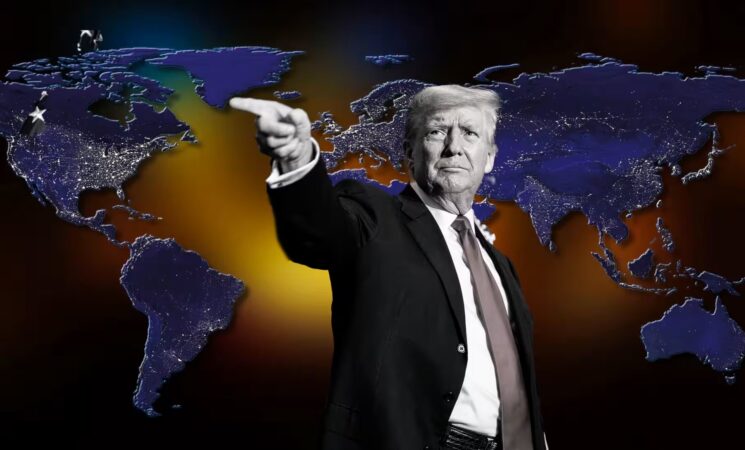21 January 2025, NIICE Commentary 9857
Shirin Sultana & Dr. Md. Abdul Latif
Nepal, a landlocked nation nestled between the burgeoning economies of India and China, stands at a pivotal juncture in its economic journey. With a population of 31.1 million and diverse landscapes from the Himalayas to the Terai region, the country is abundant in resources and opportunities. As the United States embarks on a new phase of economic strategy under Donald Trump’s leadership, often termed “Trump's 2.0 Economic Policies,” the implications for Nepal’s economy are profound. In an increasingly interconnected global landscape, these policies could significantly influence Nepal’s trade dynamics, investment climate, tourism, skilled work force migration, remittance, and overall economic stability. As Nepal navigates these uncertain waters, it is crucial for policymakers and citizens to remain vigilant and adaptable, harnessing the potential of its strategic location while addressing upcoming difficulties.
Trumpeconomics 2.0 Policy Focus
Trumpeconomics 2.0, focused on the “America First” agenda, prioritizes American workers and industries, boosts domestic manufacturing, and reduces foreign import reliance. The administration plans tax cuts for individuals and businesses to stimulate economic growth while reforming regulations to encourage investment and expansion.
Identifying as “a Tariff Man,” Trump’s platform promotes trade tariffs to protect American interests and includes potential permanent tax cuts from the Tax Cuts and Jobs Act. He plans to reduce regulations in energy, finance, and healthcare to cut compliance costs and stimulate the economy. His trade strategy includes renegotiating deals, imposing tariffs of up to 60% on Chinese goods and 10–20% globally, and promoting domestic manufacturing via bilateral agreements favoring U.S. interests.
Trump’s foreign policy will focus on nationalism, prioritizing US interests and minimizing international commitments, likely resulting in reduced participation in multilateral forums and humanitarian aid, which could diminish the effectiveness of international organizations addressing poverty and health. He will adopt a tough stance on China regarding trade, intellectual property theft, and military actions in the South China Sea.
On immigration, he plans stricter regulations, including the termination of the Deferred Action for Childhood Arrivals (DACA) program and the Public Charge Policy, while enhancing border security and imposing asylum restrictions. Regarding climate change, Trump is expected to remain skeptical of international agreements, favoring economic growth over environmental regulations, and pursuing energy independence through increased domestic fossil fuel production, including oil, gas, and coal, while rolling back environmental rules.
Challenges and Opportunities of Trump’s 2.0 Economic Policies for Nepal
Under Trump’s 2.0 economic policies, the US is expected to adopt a more protectionist approach, emphasizing “America First” principles. This could significantly alter trade dynamics. According to the World Bank’s World Integrated Trade Solution (WITS) data for 2022, Nepal's total exports amounted to approximately US$1.3 billion. Of these exports, the United States accounted for about 11.32%, equating to approximately US$147 million. The primary export products to the US included carpets and other textile floor coverings, valued at approximately US$84.67 million. If the US imposes tariffs on imports from countries like China, Nepal could become an alternative supplier for US companies, potentially boosting its vital textile and garment exports.
Trump's policies may spur US companies to invest in emerging markets like Nepal, especially in infrastructure, energy, and technology. According to the World Bank, Nepal's foreign direct investment (FDI) net inflows in 2022 were approximately $70 million, constituting about 0.16% of its GDP. This is among the lowest percentages compared to similarly positioned economies. According to the US Department of State's 2024 Investment Climate Statement for Nepal, the country has an estimated 40 gigawatts (GW) of commercially viable hydropower electricity generation potential. The US Agency for International Development (USAID) has been involved in supporting Nepal's hydropower development, indicating a focus on this sector.
According to the Asian Development Bank (ADB), Nepal’s economy is anticipated to grow by 3.9% in fiscal year (FY) 2024, up from an estimated growth of 2.0% in FY2023. This growth is driven by a 30.7% surge in tourist arrivals, increased hydropower production by over 450 MW, and a 4.3% rise in paddy production. Regarding unemployment, the Central Intelligence Agency (CIA) reports that Nepal’s unemployment rate was approximately 12.32% in 2021, 10.92% in 2022, and 10.69% in 2023. Regarding trade, the World Integrated Trade Solution (WITS) reports that in 2022, Nepal's total exports were valued at approximately USD 1.3 billion, and total imports at approximately USD 13.74 billion. However, challenges remain, including premature de-industrialization and a manufacturing sector lagging behind its regional peers.
In 2022, Nepal's outbound mobility ratio—the percentage of tertiary students studying abroad was 20.64%, compared to 1.53% for India and 1.84% for China (UNESCO, 2024). In the first nine months of fiscal year 2024, US F-1 visas issued to Nepalese students surged by 61% compared to the entirety of fiscal year 2023. the London School of Economics and Political Science (LSE) reports that personal remittances contribute significantly to Nepal's economy, accounting for 22.8% of the total GDP. Changes in immigration policies under the Trump administration may influence remittance flows, subsequently affecting private consumption expenditures essential for GDP.
Tourism is a crucial sector for Nepal, contributing about 7.9% to GDP and employing approximately 1.1 million people. The Nepal Tourism Board reported a strong inflow of 1,147,567 foreign tourists in 2023, a 13% increase from the previous year. American tourists, totaling 100,357, are a significant market for Nepal. Future tourist arrivals and tourism revenue will be greatly influenced by US travel policies and perceptions of safety.
Nepal's strategic geopolitical location in South Asia may be influenced by Trump's economic policies. China's Belt and Road Initiative has resulted in over $8 billion in pledged investments for infrastructure in Nepal. US policies could impact Nepal's delicate balance between Chinese and American interests. Historically, Nepal has fostered relationships with both India and China, with trade with India constituting about 62% of its total trade and trade with China around 14%. An increased US presence in Nepal could alter regional power dynamics, heightening competition with China and India for influence, which may affect trade agreements and foreign aid.
Policy Recommendations
Nepal’s landlocked geography, vulnerability to natural disasters, and infrastructure deficits underscore the need for regional cooperation and new development initiatives, including the BRI. As Nepal prepares to graduate from the least developed country (LDC) status in 2026, there are concerns about losing international support crucial for its industrialization, economic diversification, and job creation. To enhance trade relations, Nepal should diversify its export markets beyond the US to reduce risks from protectionist policies. It should negotiate favorable trade agreements to improve market access for Nepali products.
Improving the investment climate through regulatory reforms and incentives for US investors is vital. Simplifying business regulations and reducing bureaucratic obstacles will attract foreign direct investment (FDI). Targeted incentives for US companies in sectors like hydropower, infrastructure, and technology are essential. Additionally, programs supporting Nepali students studying abroad, especially in the US, can enhance skills and increase remittance flows, while engaging the diaspora to foster investment and knowledge transfer to Nepal. Boosting the tourism sector through targeted marketing campaigns in the US, along with investments in safety and infrastructure, can enhance Nepal's appeal as a tourist destination.
Nepal should strategically leverage its geopolitical position through capacity-building efforts. A balanced foreign relations approach, engaging both the US and China, can maximize benefits while minimizing risks. Strengthening regional cooperation to tackle shared challenges like infrastructure development and disaster management is crucial. While pursuing economic growth, it is important to implement environmental regulations to safeguard Nepal’s natural resources and promote sustainability. Investing in diverse sectors beyond tourism and remittances, such as technology and manufacturing, will contribute to a more resilient economy.
Conclusion
Implementing Trumponomics 2.0 could significantly alter Nepal's economy by improving trade relations, drawing foreign investment, and promoting growth. The success of the country will depend on its ability to adapt to and capitalize on these changes for future prosperity.
Shirin Sultana is a Research Associate and Dr. Md. Abdul Latif, is an Additional Director, Bangladesh Institute of Governance and Management, Dhaka.

